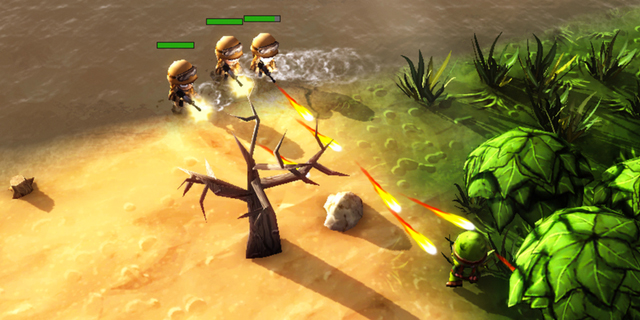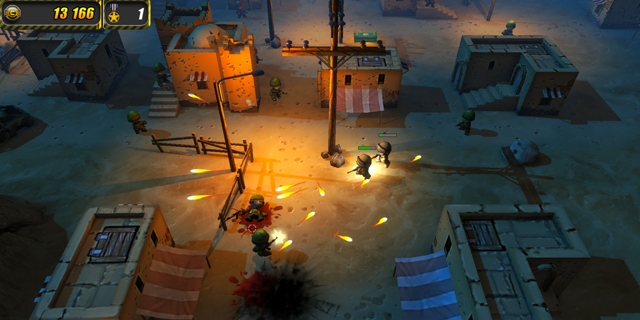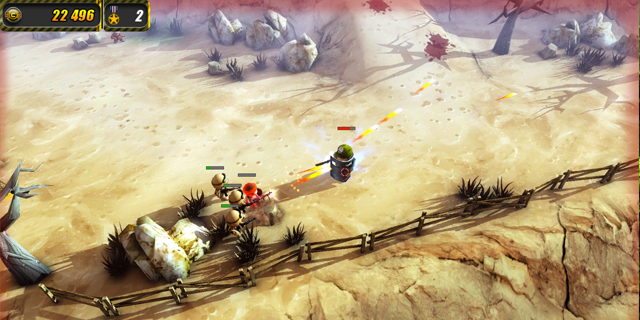
Back in the early ’90s, there was an interesting little tactical shooter called Cannon Fodder. In it, you commanded a small squad of soldiers by clicking around a battlefield, commanding them when to attack and retreat. It was a fun little game, and had enough success to garner a sequel, but not much was heard out of the series for a long time after that (until just recently when Cannon Fodder 3 was released on Steam, but that’s another story).
Why bring up Cannon Fodder during the review of a different game? Well, let’s just say that said differences are actually pretty few and far between. It’s clear from a simple glance that Tiny Troopers borrows a great deal from the former, but does that make it less of a game?
The gameplay in Tiny Troopers (and Cannon Fodder) is simple but gratifying. You move your squad by left-clicking on a location, and command them to attack by right-clicking. Only one key is used to dictate special attacks such as grenades, rockets, and air strikes, so I commend the use of a simple, easy-to-learn interface. Gradually moving your team around the map, sneaking up from the right angle to pick off enemy troops is just as rewarding as it is in any other good shooter.

Fighting some of the larger enemies (such as tanks) are a lot of fun, but it takes a very long time to take them down. Continually clicking to dodge back and forth while shooting for what can sometimes be up to two minutes can get repetitive, especially if you are dealing with stragglers at the same time. Conversely, you can use the tactic of finding a spot just barely out of the unit’s vision and command your troops to take pot shots at them, but at that point, you might as well just get up from your computer to watch TV while you slowly whittle down their health, and that’s just as boring. I should never have to exploit a game during normal play, and Tiny Troopers makes it far too easy to do.
However, the shooting is fun for most of the game’s duration, and will likely be motivation enough to continue to the next mission. It’s still essentially a carbon copy of the gameplay mechanics of Cannon Fodder, so don’t expect anything new here. The only complaint I can levy against the game is that since the controls could have been more effective as a twin-stick shooter.
An interesting feature about the two games is how they handle the individual troops you are given. Every single soldier has a name. This may seem irrelevant at face value, but when you consider the fact that when a soldier dies in either of these games, they are gone for good, and there is nothing you can do to get them back. It shows that the designers of both games wanted to highlight the true gravity of war by juxtaposing the serious issue of mortality against a cartoonish artistic direction. The last time I felt any sort of connection to the soldiers I was commanding in a war game in this manner was in Valkyria Chronicles, which also emphasizes the idea that each soldier is an individual. It’s a very intriguing mechanic that I wish we saw more of in war games.

What sets Tiny Troopers apart from its vintage inspiration is the upgrade system. During each mission, you are awarded command points for completing specific actions, like killing enemy soldiers, disarming bombs and collecting dog tags. These points can be spent on temporary upgrades that can be used to help you during difficult missions. You can find hidden medals scattered around the maps that can be exchanged for permanent upgrades to all present and future soldiers. My favorite part about the system is that, after each mission, your surviving soldiers “level up”, becoming slightly stronger. These levels are lost when a soldier dies, so it really keeps you on your toes, and forces you to be very careful to not let anyone die in combat. I always love it when a game uses its mechanics to hammer home its theme, and Tiny Troopers takes the next logical step.
The graphics are simplistic and the art direction is cartoony, showing the game’s roots as a mobile title before making the jump to computers. There’s nothing inherently wrong with this, considering it is a port, but I have been seeing this trend a lot in PC games lately: when a title goes from mobile to PC, little to no effort is made in improving the game for higher-end hardware. I understand wanting to keep the style consistent and keep costs down, and I’ve never been a stickler for graphical fidelity, but when your game sees a tenfold price increase when going to a new platform, I don’t think it’s out of the question to see that money go towards some major improvements.
As I keep saying, the art direction of the game borrows very heavily from Cannon Fodder. I really don’t like drawing so many parallels between these two games, but when they are so much alike, it’s just impossible not to. Missions take place primarily in deserts, jungles and tundras. You’re even brought in on a helicopter to start each mission. I would have preferred to see the developers take the former’s formula and run with it, taking it in new and fresh directions, but it feels like I’m looking at essentially the same game with a new coat of paint. Heck, even Cannon Fodder 3 did more to change up the formula than Tiny Troopers.
Moreover, the music in the game is virtually nonexistent, save for a select few tracks used for menus and ends of missions. A little bit of audio would have been a nice touch to add in the computer version, as it wouldn’t have been as necessary in the mobile original. There are humorous little sound bytes that you can hear from the soldiers, but they do get repetitive after several missions. Overall, I don’t think Kukouri quite yet grasps the nuances of the PC platform, and what it means when you port your game to it from a mobile device.
When you get down to it, it’s quite simple: If you like Cannon Fodder, you will like Tiny Troopers. I believe that, taken for what it is, Tiny Troopers is a well-made game, and whether it is a loving homage or an outright copy is irrelevant in the grand scheme of things.
Pros: Solid mechanics, flexible upgrade system, rewarding missions
Cons: Little originality, lackluster visual flair, iffy controls



















